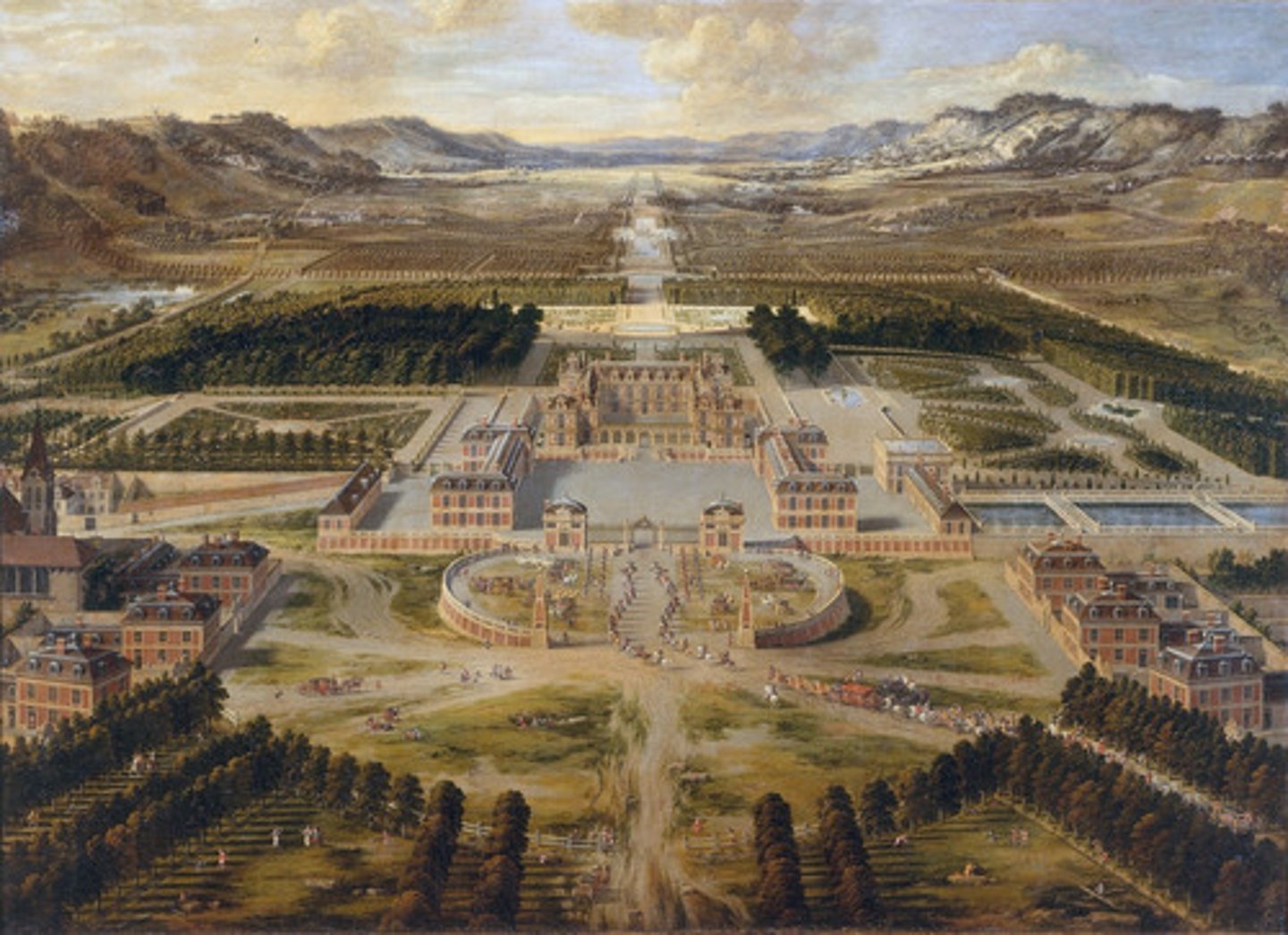Art history 225b Baroque Art
1/28
There's no tags or description
Looks like no tags are added yet.
Name | Mastery | Learn | Test | Matching | Spaced |
|---|
No study sessions yet.
29 Terms
chiaroscuro
Italian word designating the contrast of light & dark in a painting, drawing, or print; chiaroscuro creates spatial depth and volumetric forms through gradations in intensity of light and shadow
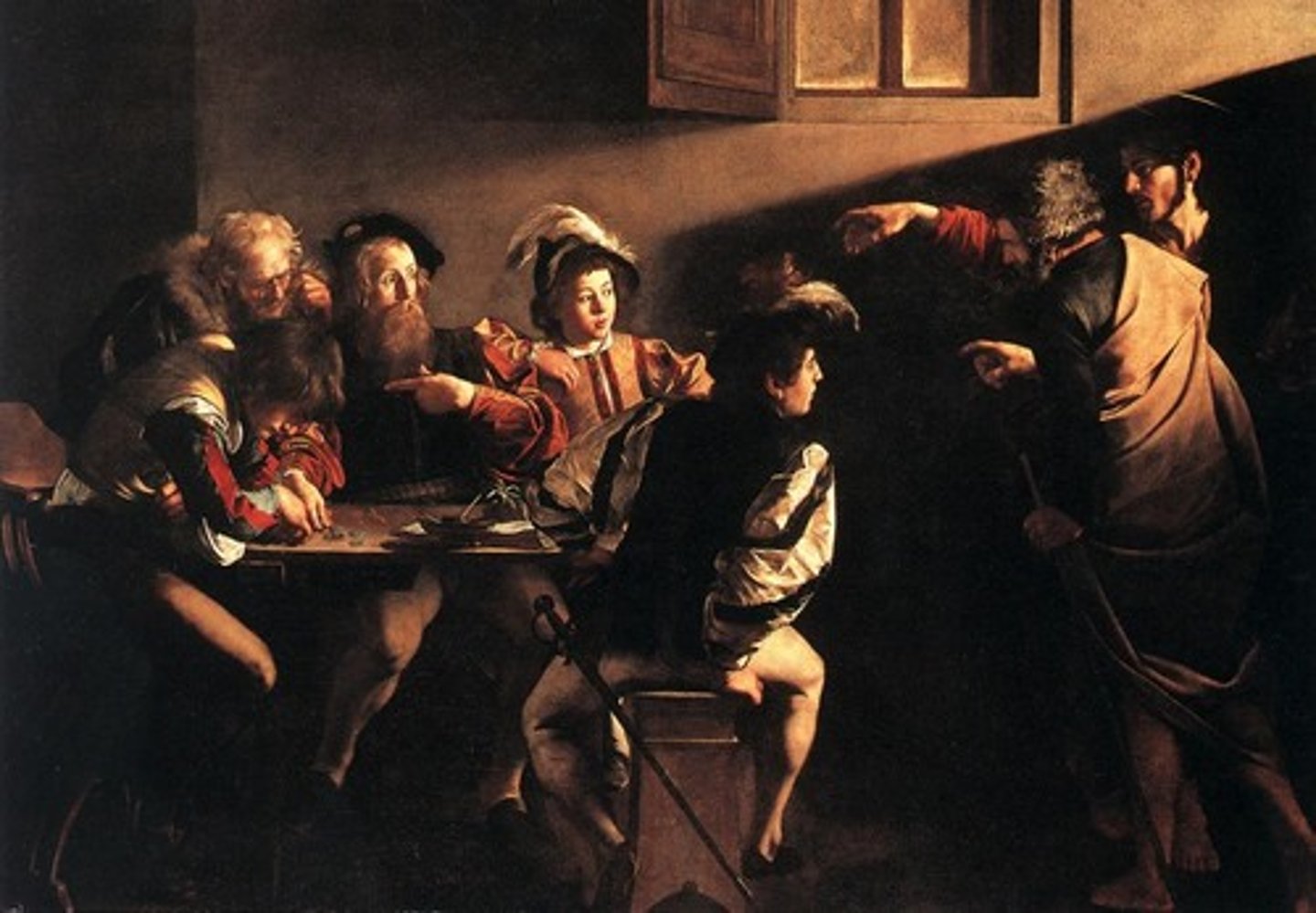
tenebrism
a technique in which forms emerge from a dark background into a strong light that often falls from a single source outside the painting; the effect is that of a modern spotlight (see Caravaggio and Artemisia Gentileschi)
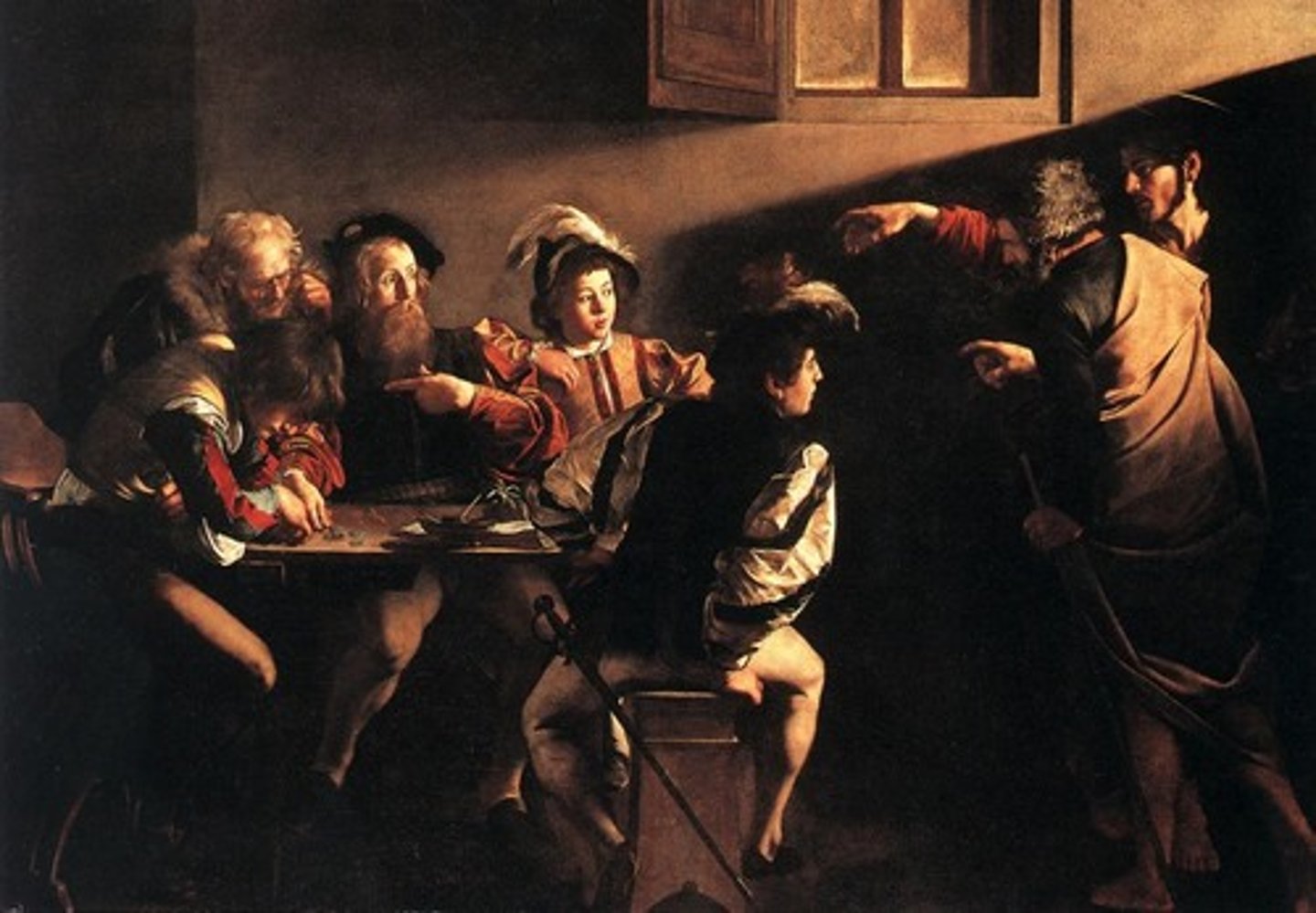
di sotto in su
"from below to above"; resulting viewpoint created through use of quadratura

quadratura
literally "squaring" or "gridwork"; an architectural setting painted in meticulous perspective and usually requiring that it be viewed from a specific spot to achieve the effect of soaring space
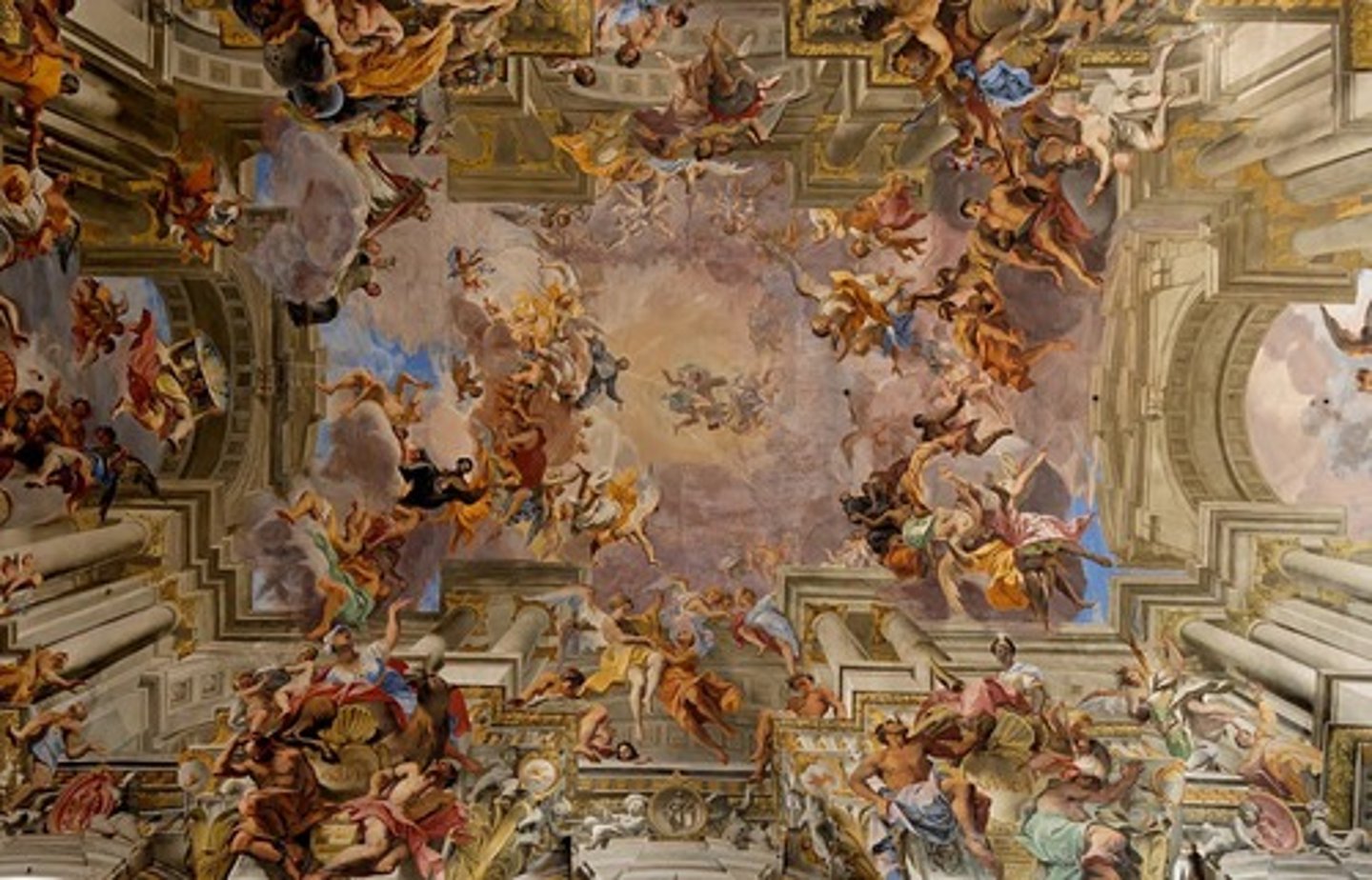
colonnade
a row of columns supporting a straight lintel or a series of arches (see Bernini in St. Peter's piazza)
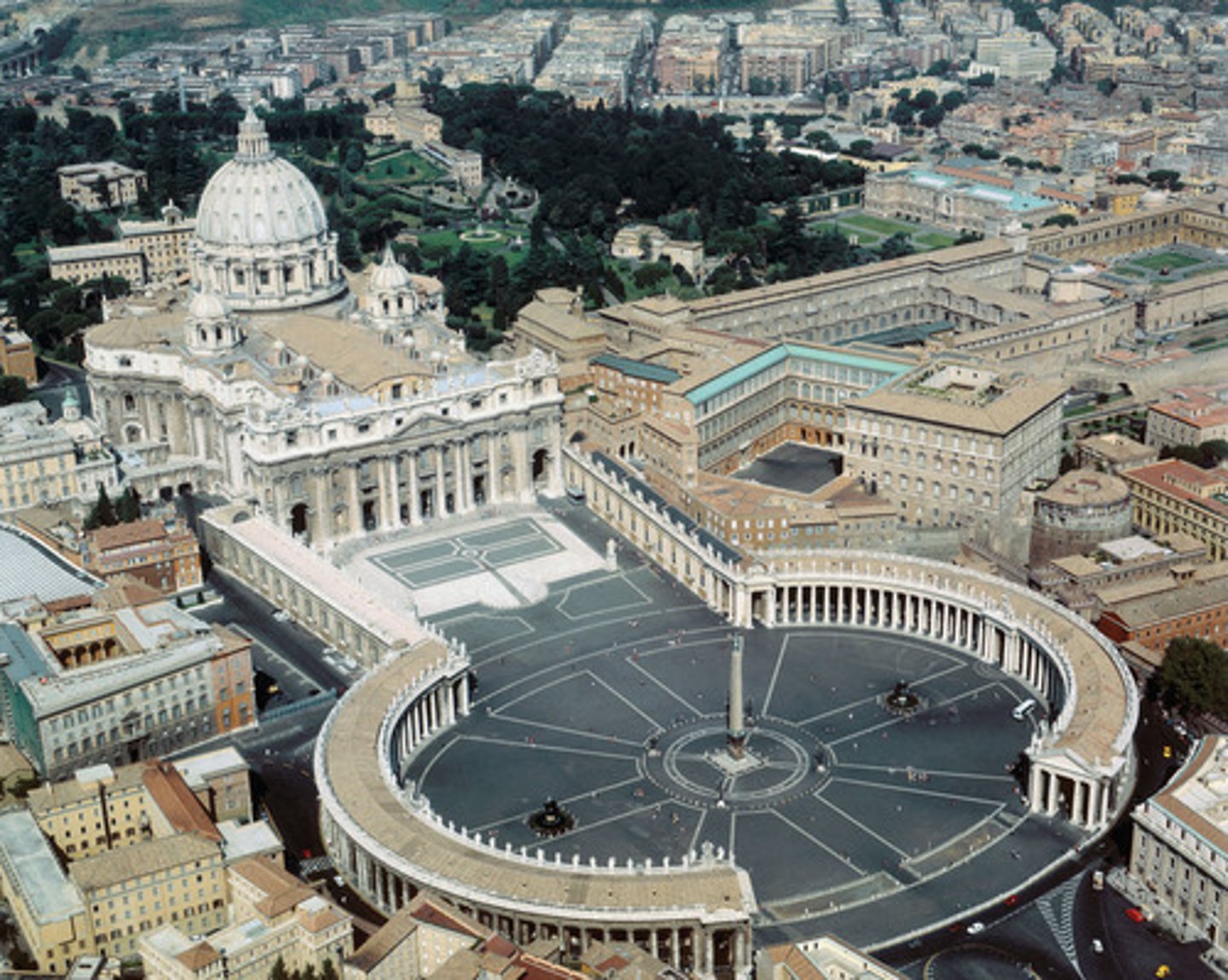
baldachin
a canopy placed over an honorific or sacred space such as a throne or a church altar
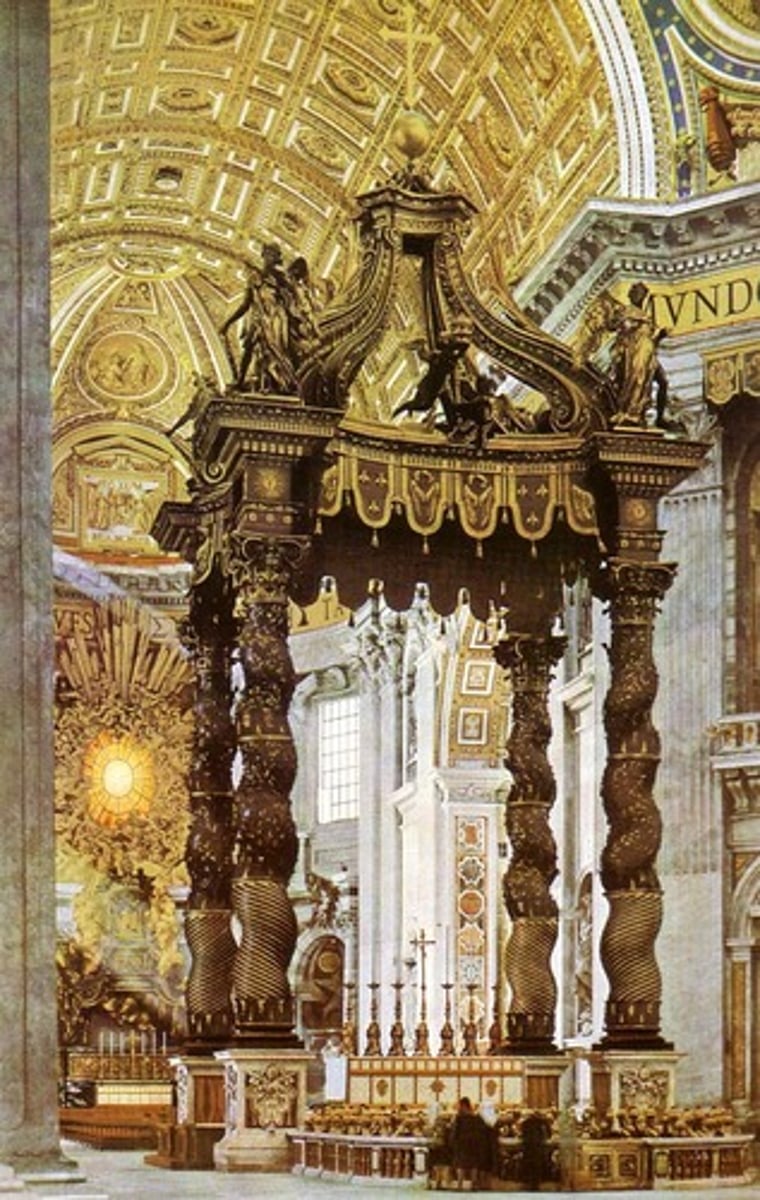
impasto
thick applications of pigment that give a painting a palpable surface texture
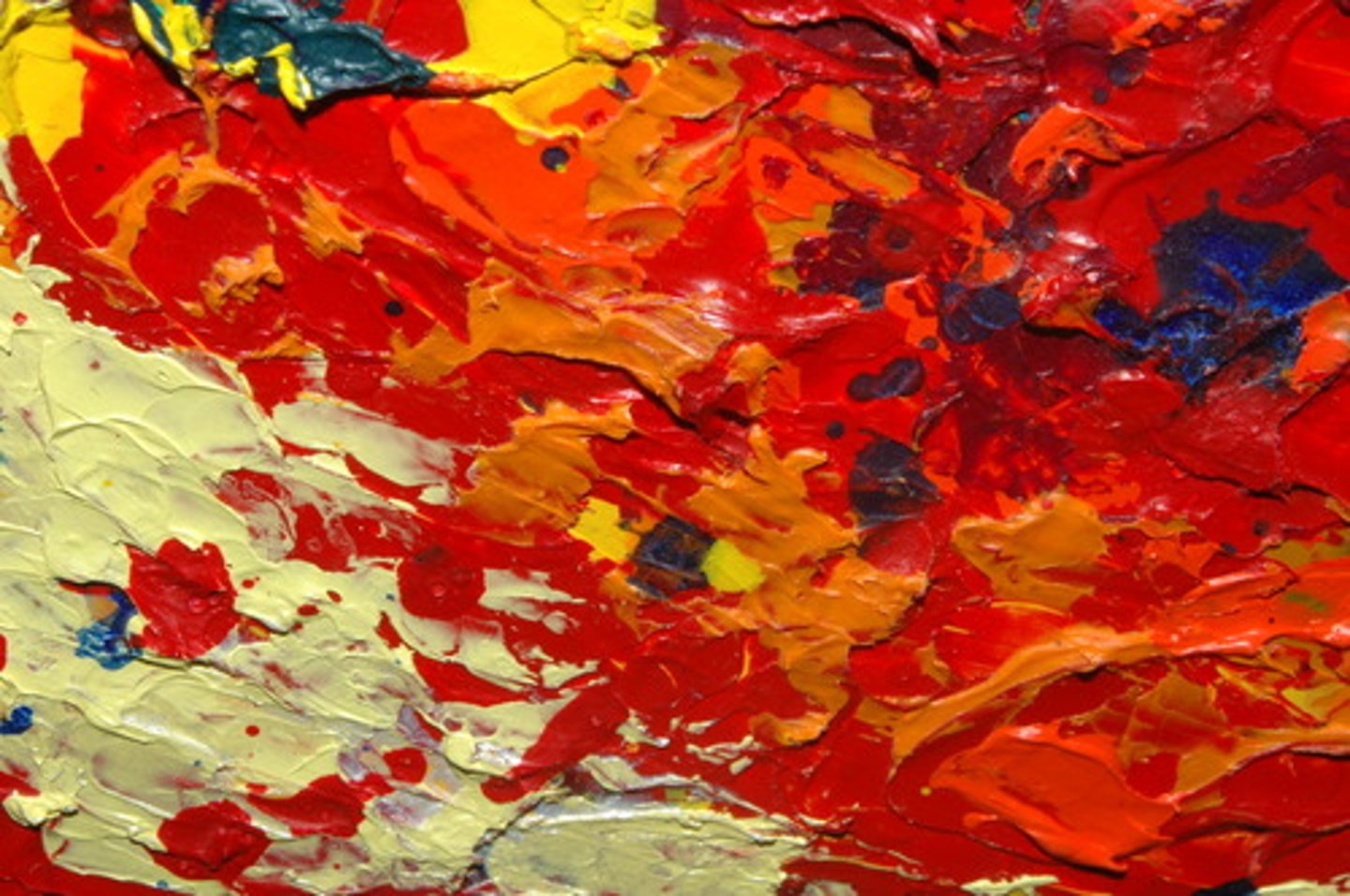
vanitas
a type of image, especially popular in 17th-century Europe, in which objects symbolize the transience of life still life: a type of painting that has as its subject inanimate objects (such as food, dishes, fruit, flowers, etc.)
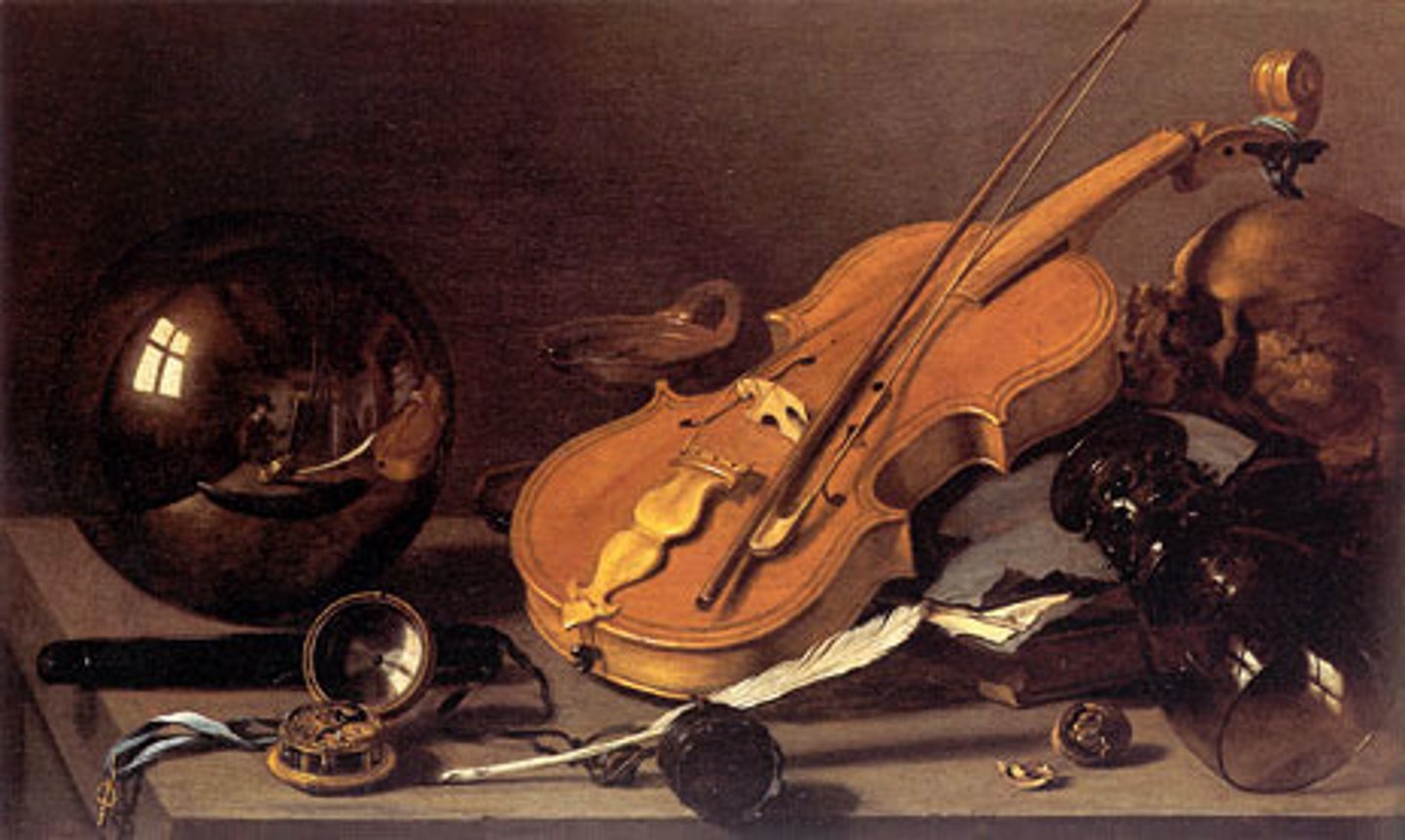
camera obscura
an early camera-like device; made from a dark box (or room) with a hole in one side (sometimes fitted with a lens), the camera obscura operates when bright light shines through the hole, casting an upside-down image of an object outside onto the inside wall of the box (or room)
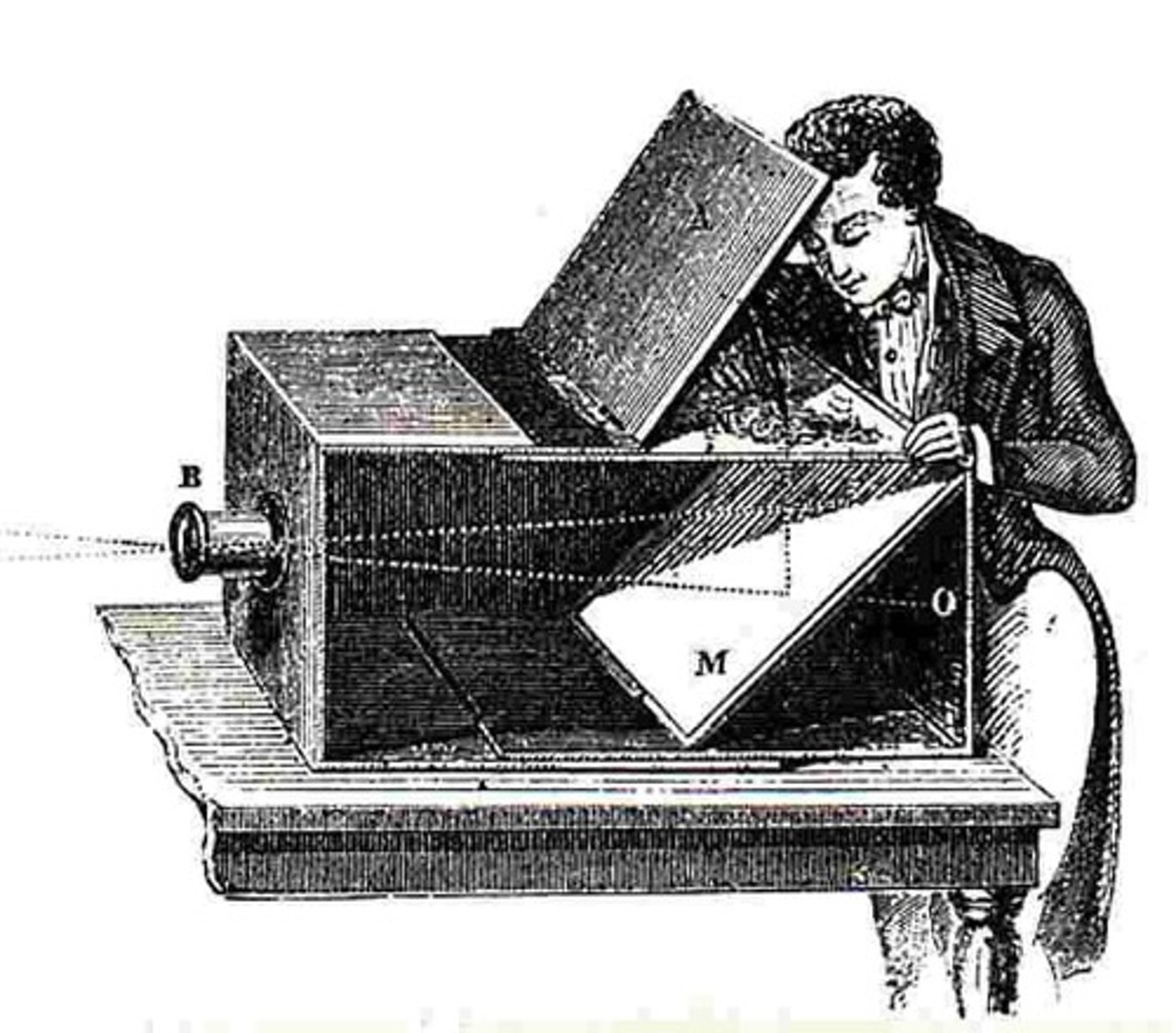
Where does the Baroque style originate? What is the reason for this? [think what is the relationship between the Catholic Church and Baroque art?]
Born in Rome, Italy; developed against the backdrop of the counter-reformation, so the art would bolster the church's authority as well as the royal authority.

Is the Baroque style a complete break from the art that preceded it? Do artists of the 17thc carry over ideas, traditions, styles, etc. from earlier centuries? [think Rubens, Bernini, among others]
Drawing from antiquity (just like the renaissance) and bodies were modeled very similarly after Michelangelo and Caravaggio's figures. Much art was commissioned for the church as well as now for the middle class home. New genres: still life, landscape, genre
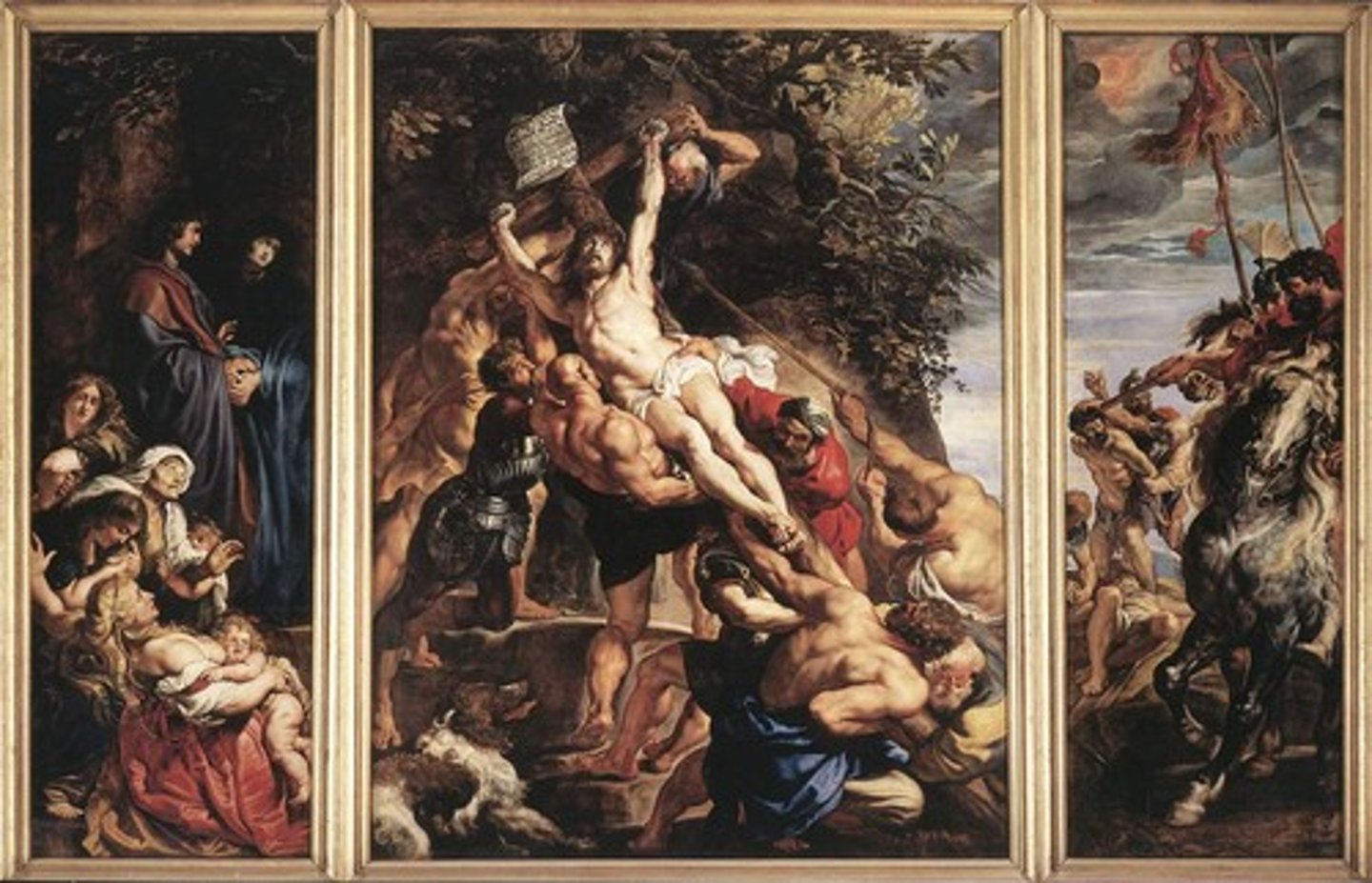
Be able to characterize (generally, of course) the artistic style of the Baroque. Think about what makes something a Baroque painting, a Baroque sculpture, a Baroque building, esp. vis a vis the Renaissance.
Dramatic lighting, gestures, and facial expressions. Use of diagonals. Designed to draw the viewer in. Captures the most dramatic moment. Pushed up close to the picture frame. Modern clothes, naturalistic (not idealized)
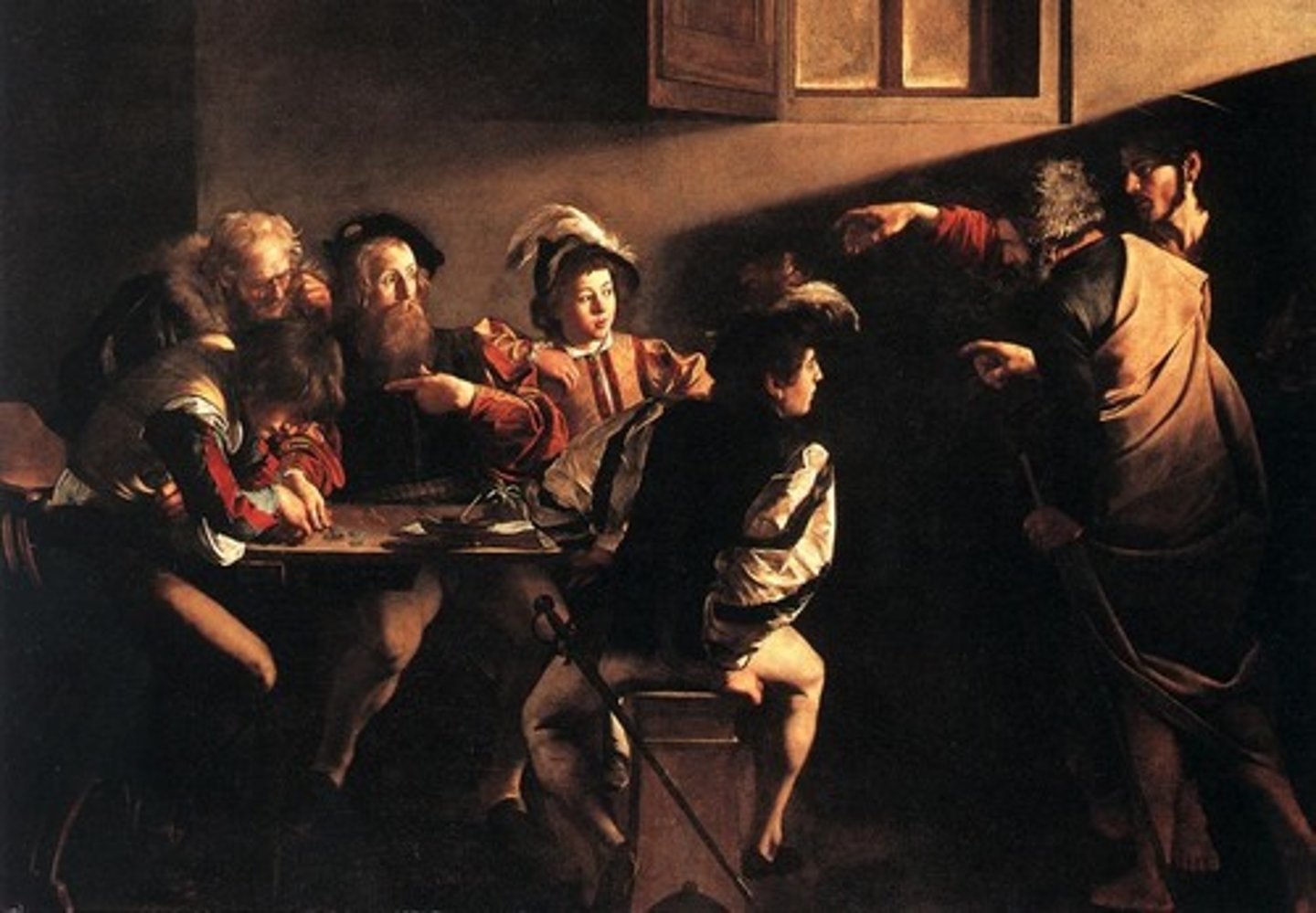
What are the innovative stylistic features that Caravaggio introduces to Baroque art? What is the effect of Caravaggio's art on the viewer? How are his paintings tied to the context of the Baroque period? Why was his artwork at times considered controversial?
Caravaggio incorporated a self-portrait, commenting on this idea of the status of the artist. Dirty hands, dirty feet - depicting people as they really are. Some people did not like this because the bodies were not idealized.
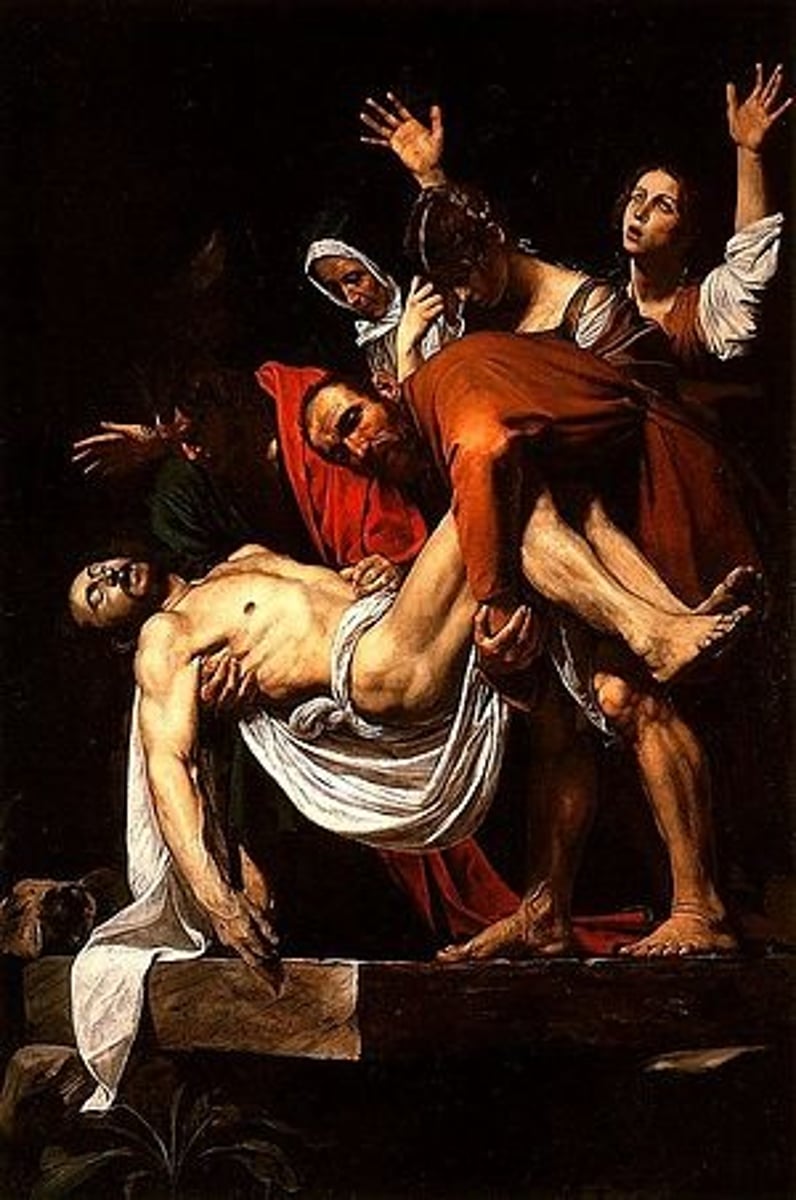
Consider the subject matter of Bernini's Ecstasy of St. Teresa and Zurbaran's St. Serapion. How do both of these works serve the Counter-Reformation Church? What was their function? Where were they located? Who was their audience?
St. Teresa was just becoming a saint at the time this was made, so this was the Catholic church emphasizing its power in a time when it was threatened. It was made to be in a chapel. St. Serapion was comissioned to hang in a funerary chapel by a spanish order of monasteries that was founded to rescue Spanish missionaries from the Moors. This captures the martyrdom of St. Serapion, representing the conflict between the Catholic and Protestant faiths.
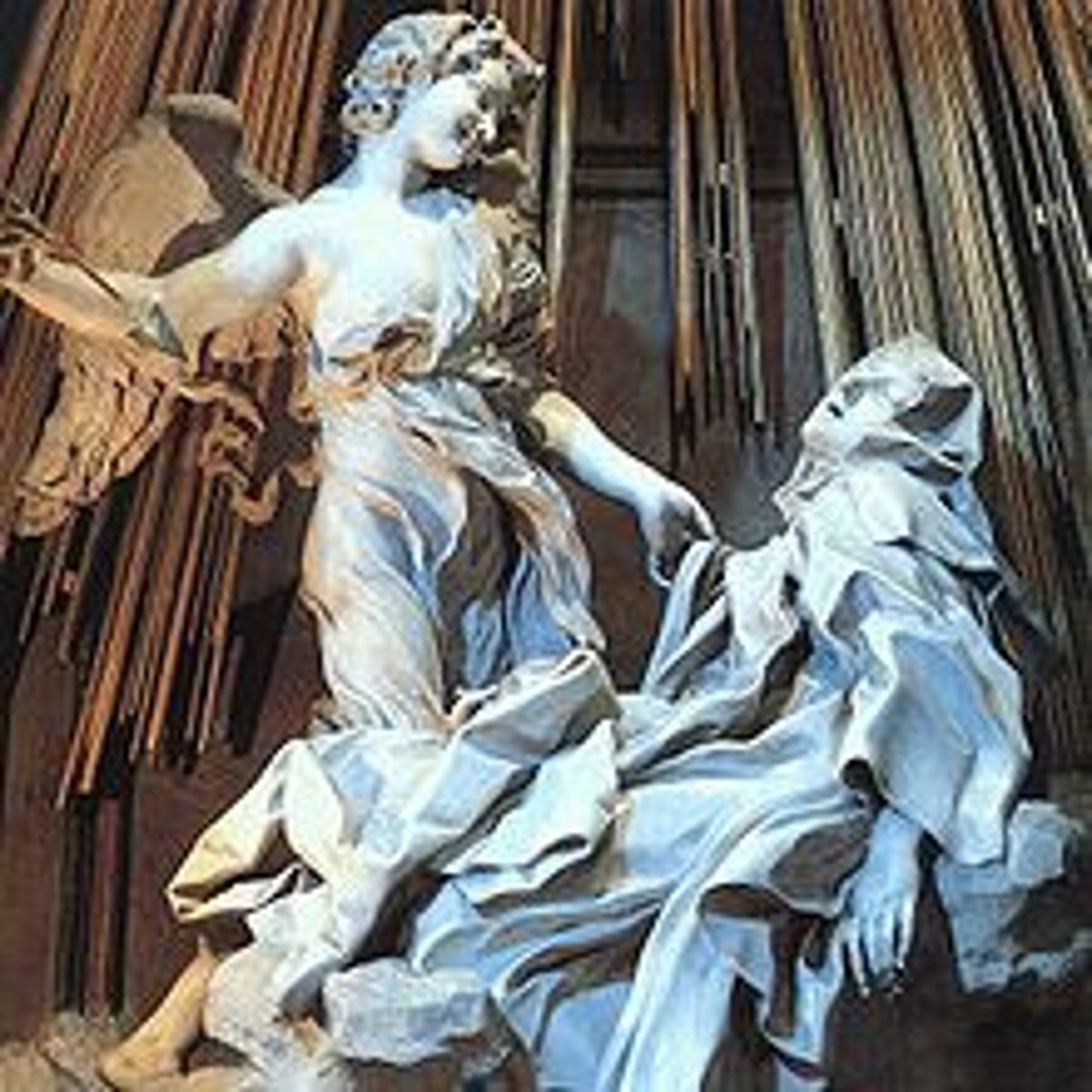
What is the difference between quadro riportato & di sotto in su ceiling decoration? What is the effect of each? Be able to give an example of each type!
Quadro Riportato utilizes painted on architecture to create an illusion, such as the Sistine Chapel. di sotto in su creates an illusion by you standing in one particular spot and looking up. Ex: Glorification of Saint Ignatius
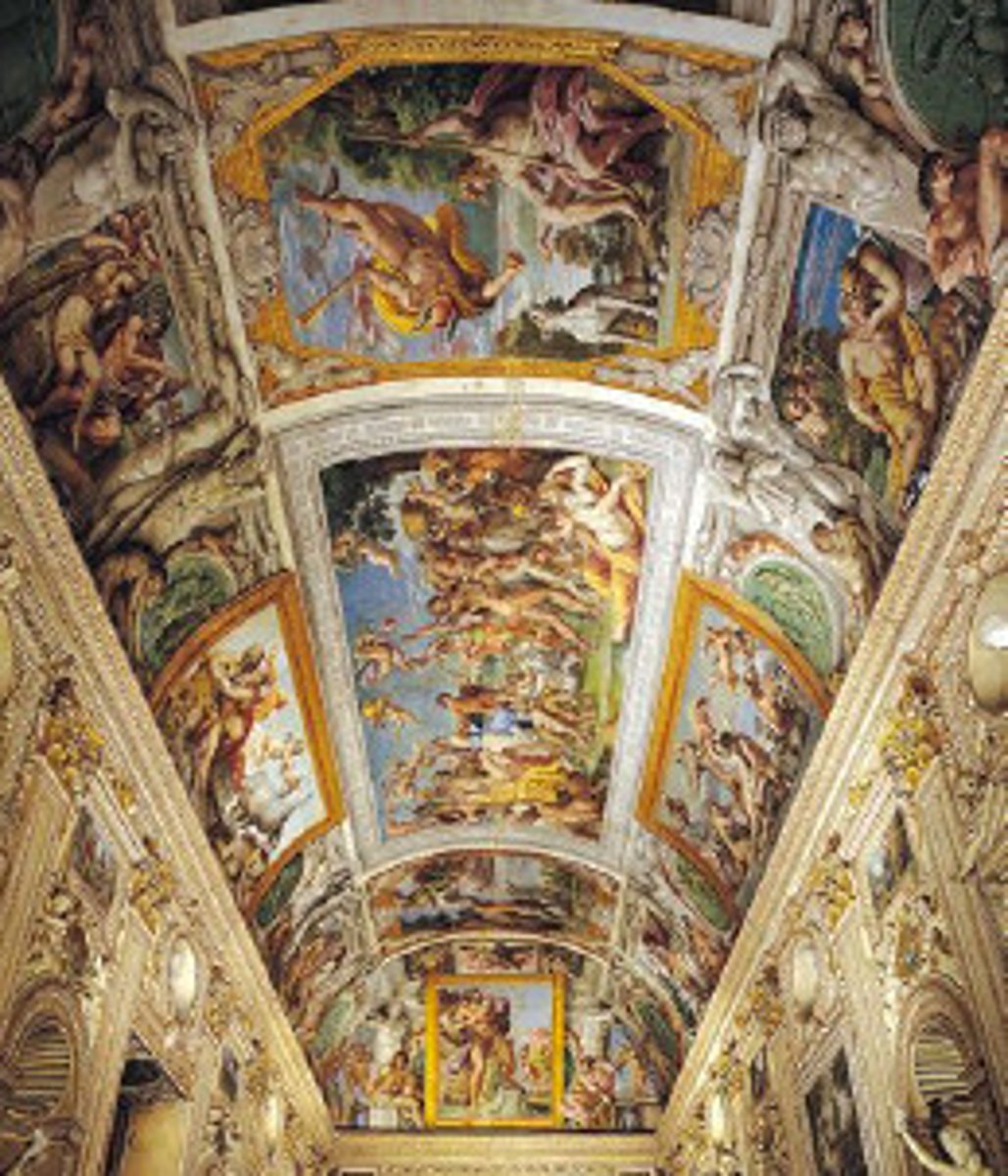
The monarchs of Spain & France are great patrons of art during the Baroque. What types of art do they commissions and why? What do they hope to achieve with art? (think Velazquez's Surrender of Breda - where was it originally placed? What was its message to the viewer? Compare and contrast this with Marie de' Medici's commissions from Rubens)
The monarchs would have commissioned art that would represent their authority, power, and victora. Ex: Velazquez's Surrender of Breda showed an overwhelming victory for Spain, but it was all a lie - propaganda. While these would bring honor to the country as a whole, Marie de' Medici's commissions would really only glorify her.
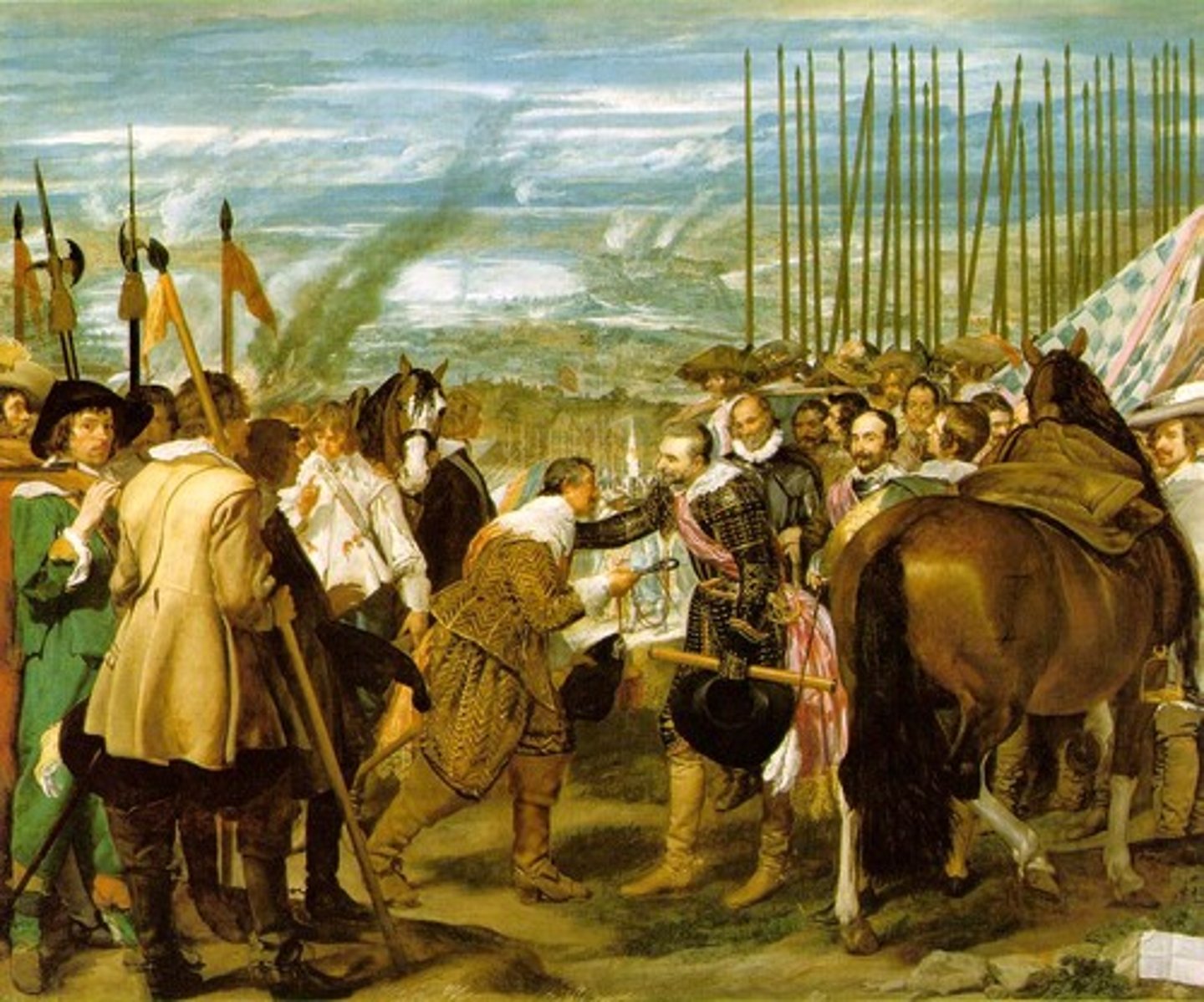
What is the subject of Velazquez's Las Meninas? Defend your answer by making specific reference to the composition of the painting.
Las Meninas shows Velazquez painting a portrait of the king and queen. The viewer is the king a queen. He put himself in this painting as a commentary on the status of the artist.
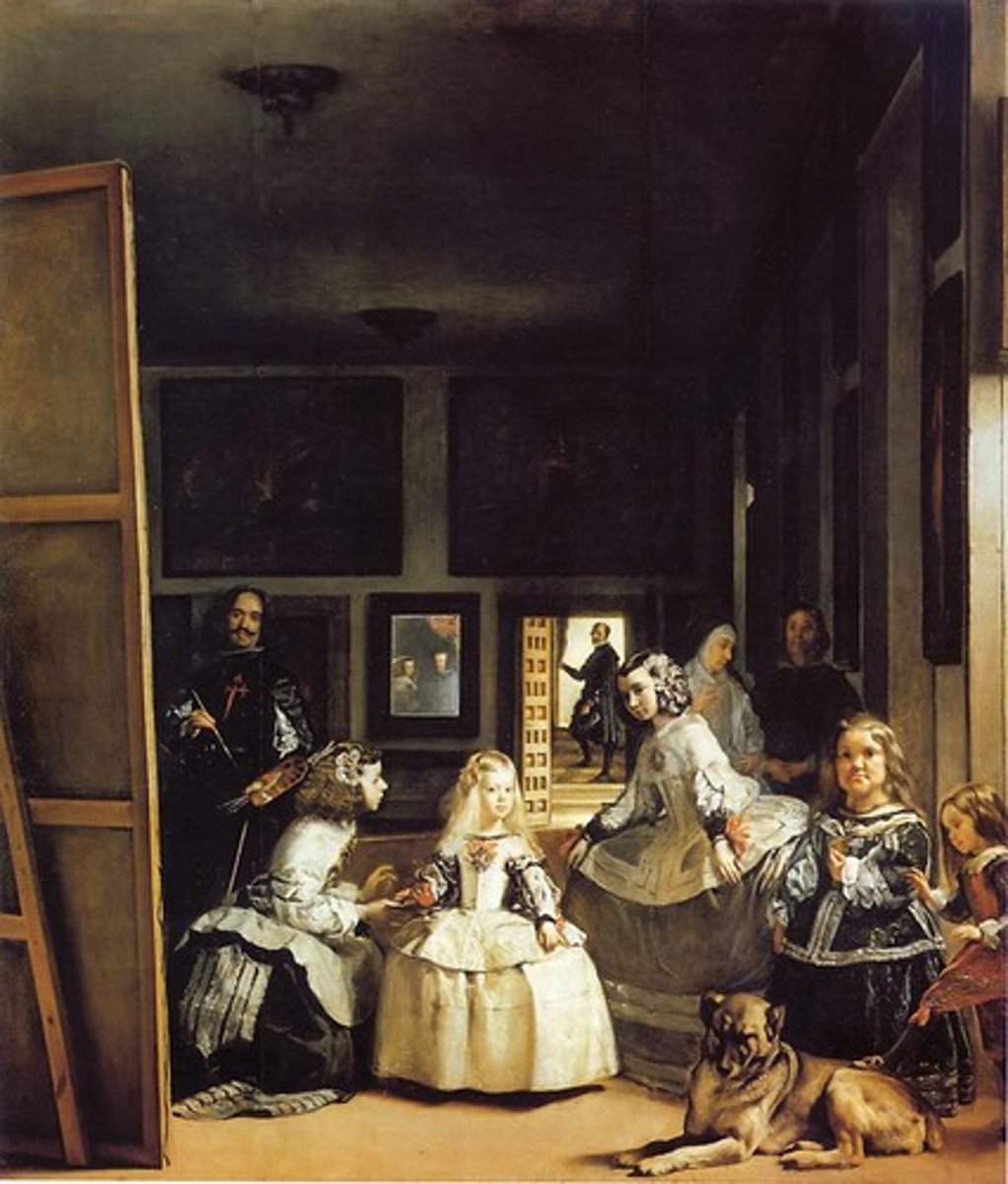
What evidence do we see for the elevation of the status of the artist in the Baroque period? [think Velazquez, Rembrandt, etc.]
Velazquez put himself in a painting among royalty. Rembrandt would go above and beyond just to show the skill he was capable of (ex: Anatomy Lesson that started with the arm). Rembrandt also made more self-portraits than anyone else and we got to see how his perception of himself change over time.
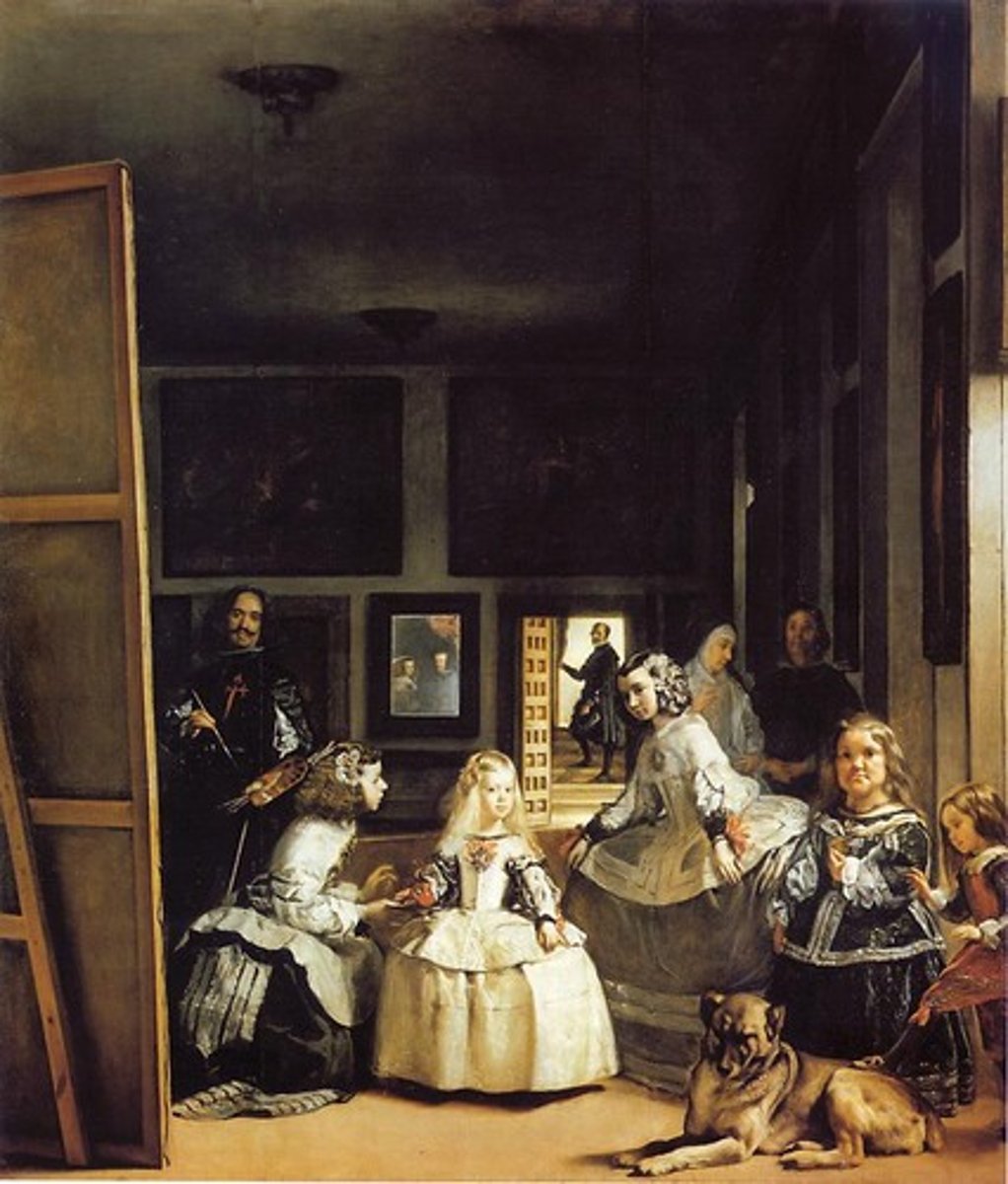
How does Baroque art differ in the Dutch Republic (versus Italy, Spain, Flanders, France)? (think religion, economics, politics, etc., i.e. context)
Italy - heavily influenced by religion and mythology.
Spain - Lots of commissioned works to bolster authority of the church
Flanders - Catholic, pieces made for alters
France - Catholic monarchy. Art represents power of monarchy.
THE DUTCH REPUBLIC - protestant, no pope, no royal family. Introduce genre, landscpes, still lifes, and portraits, developing an art market bc there is no specific patron.
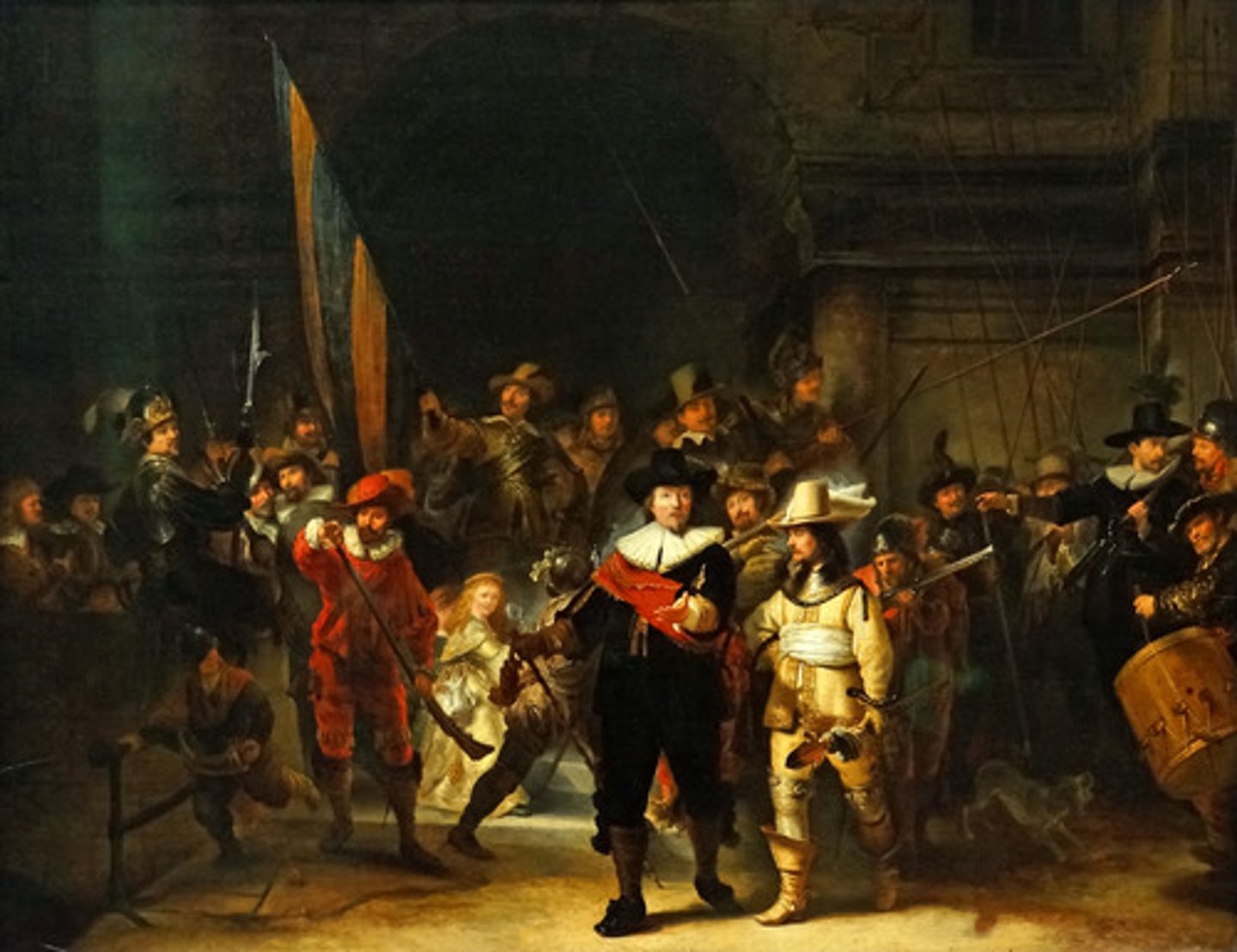
How does the absence of the Catholic Church in the Dutch Republic affect artists and patrons? (think who commissions art work and what genres of art work do they commission? Why do they want art? What do they want to see in their art? Is any religious art produced? Who is it for and what does it look like?)
There are no specific patrons, so an art market is created. New types of paintings - genre, landscapes, still lifes, portraits. They start commissioning group portraits, and people liked art that was representative of the artist. the only religious art that was produced was a painting on the interior of a church, which was much more bare than how the Catholics had it.
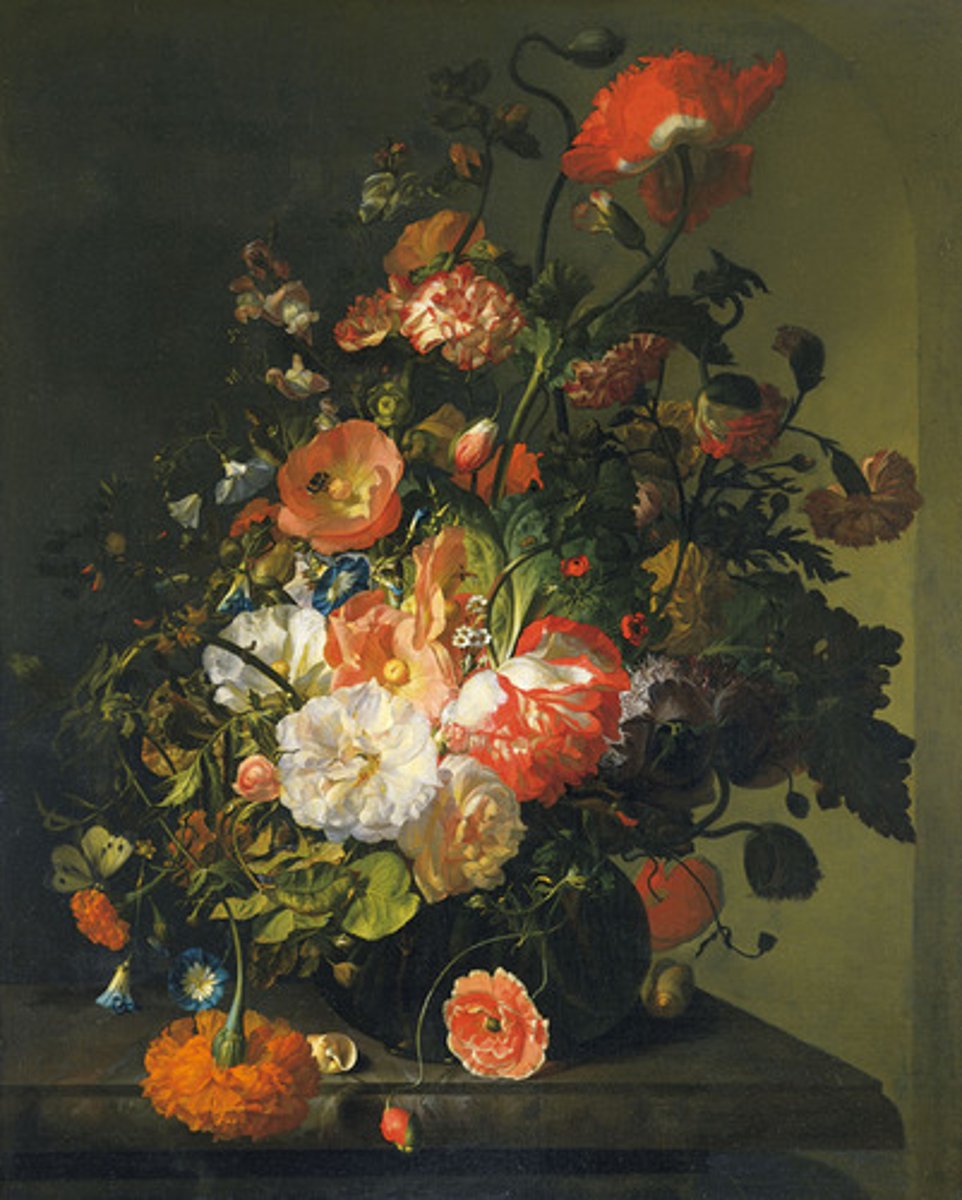
What was the function of the group portraits produced by Hals and Rembrandt? Who were the subjects? Where were they placed? What are the stylistic elements of these portraits that mark them as Baroque?
Group portraits were made for guilds or militias and would be placed in their meeting rooms. There was almost always a sense of movement or being caught in the moment. Baroque elements: dramatic lighting, gestures, expression. Draw the viewer in .
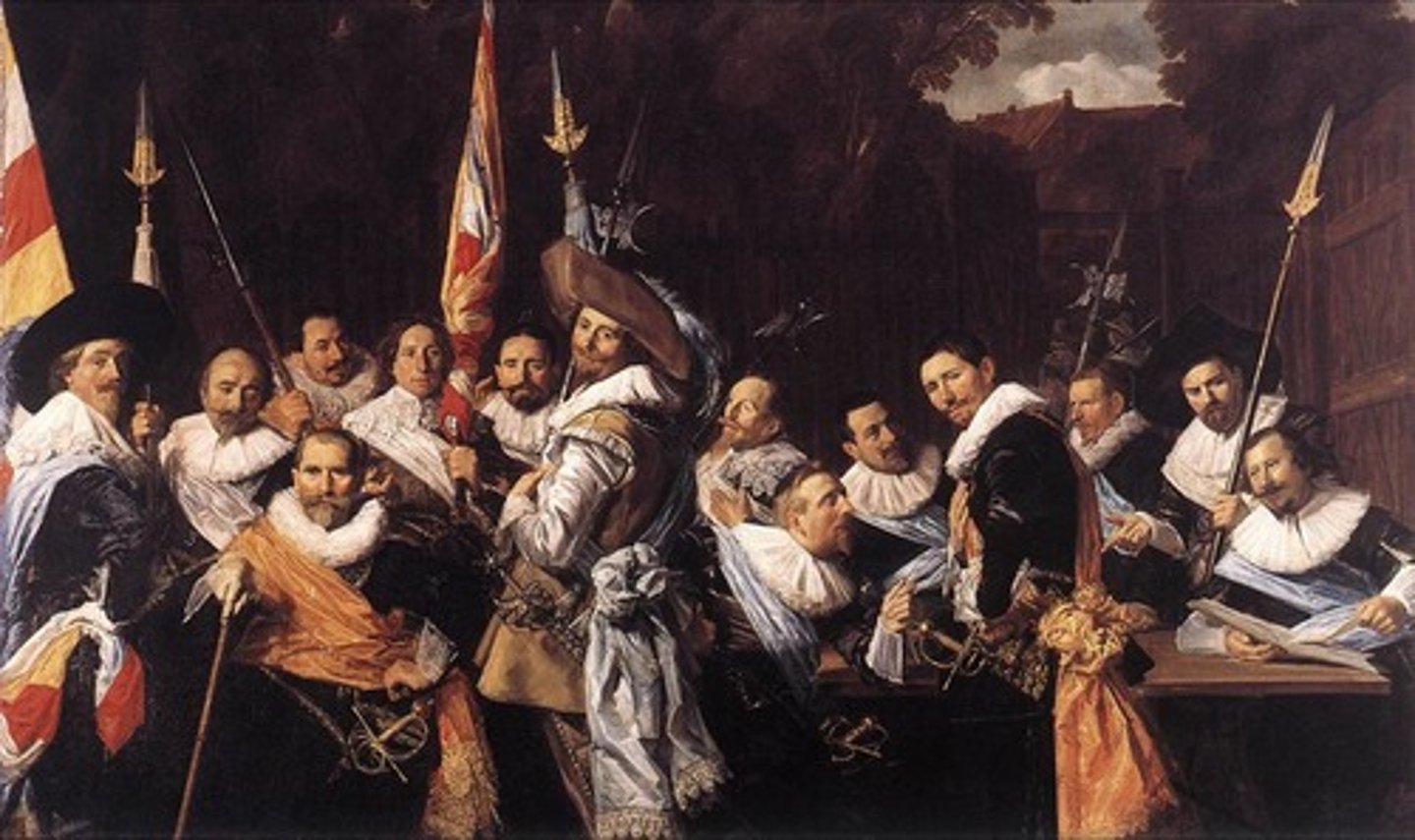
Characterize Baroque architecture. Is it stylistically similar to Baroque style painting and sculpture? How does it compare to Renaissance architects like Alberti and Palladio? (think Bernini & Borromini, but also about Le Vau & Hardouin-Mansart at Versailles)
Baroque sculpture captures the most dramatic moment and lighting and is often commissioned by a high-ranking member of the church. It is similar to the renaissance in that it has a religious purpose, but Borromini made an oval church (not basilica) and Versailles artists made us gape in awe of Louis and have him at the center.

How do women artists fit into the Baroque period? What are their challenges? What types of works of art do they produce? What about women patrons?
Women's education and career opportunities are limited. Female founders of the painters guild were not represented, and females were thought to be too sensitive to study nudes. They often made art that portrayed powerful women or that would actively capture their skill and status as artists. Women patrons often commissioned works that would honor themselves.
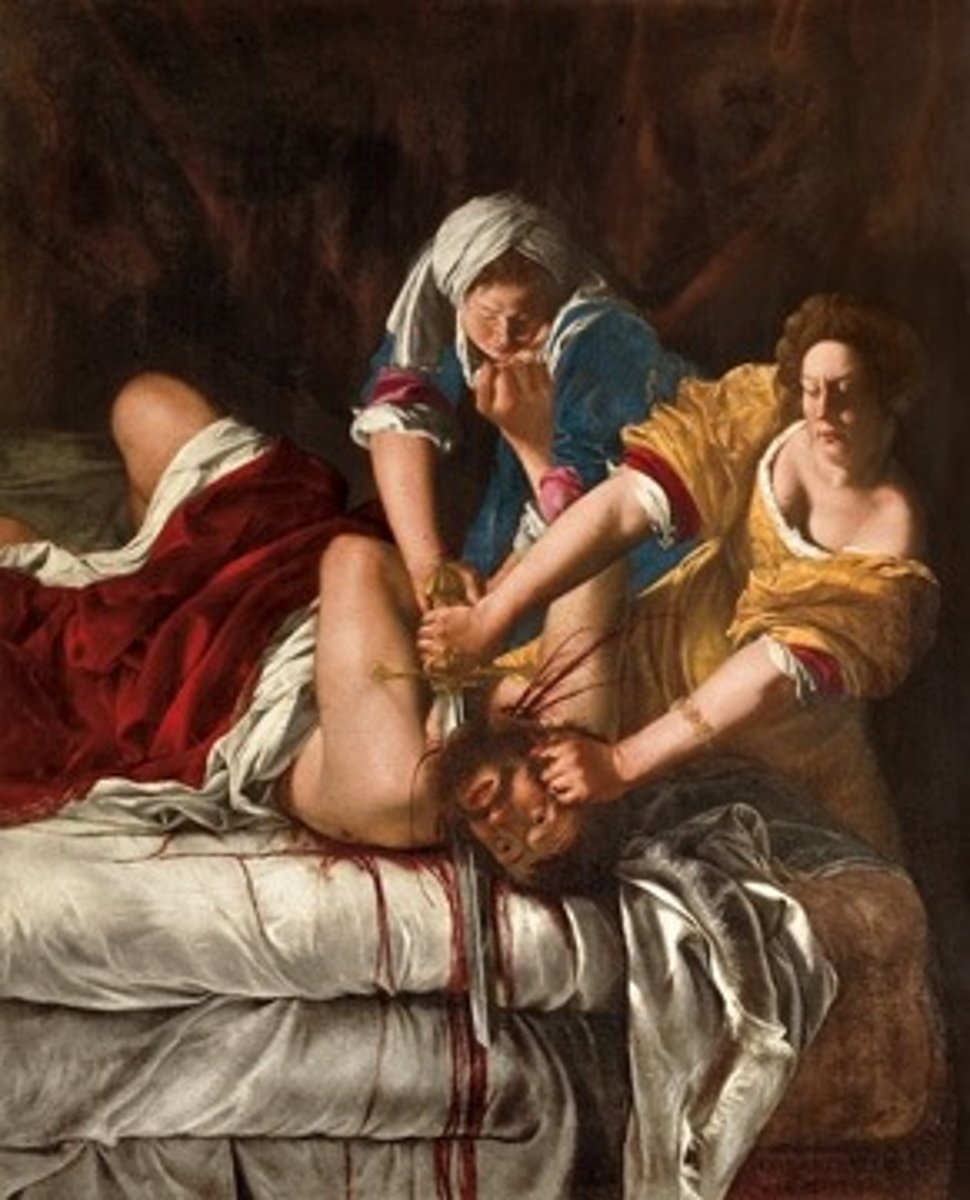
Dutch painters frequently employ vanitas motifs in their works. What is the significance of vanitas? Identify at least two paintings employing vanitas symbolism.
Vanitas reminds us that death is coming by using skulls, hourglasses, and watches. Ex: Claesz's Vanitas Still Life and Antonio de Salgado's Vanitas
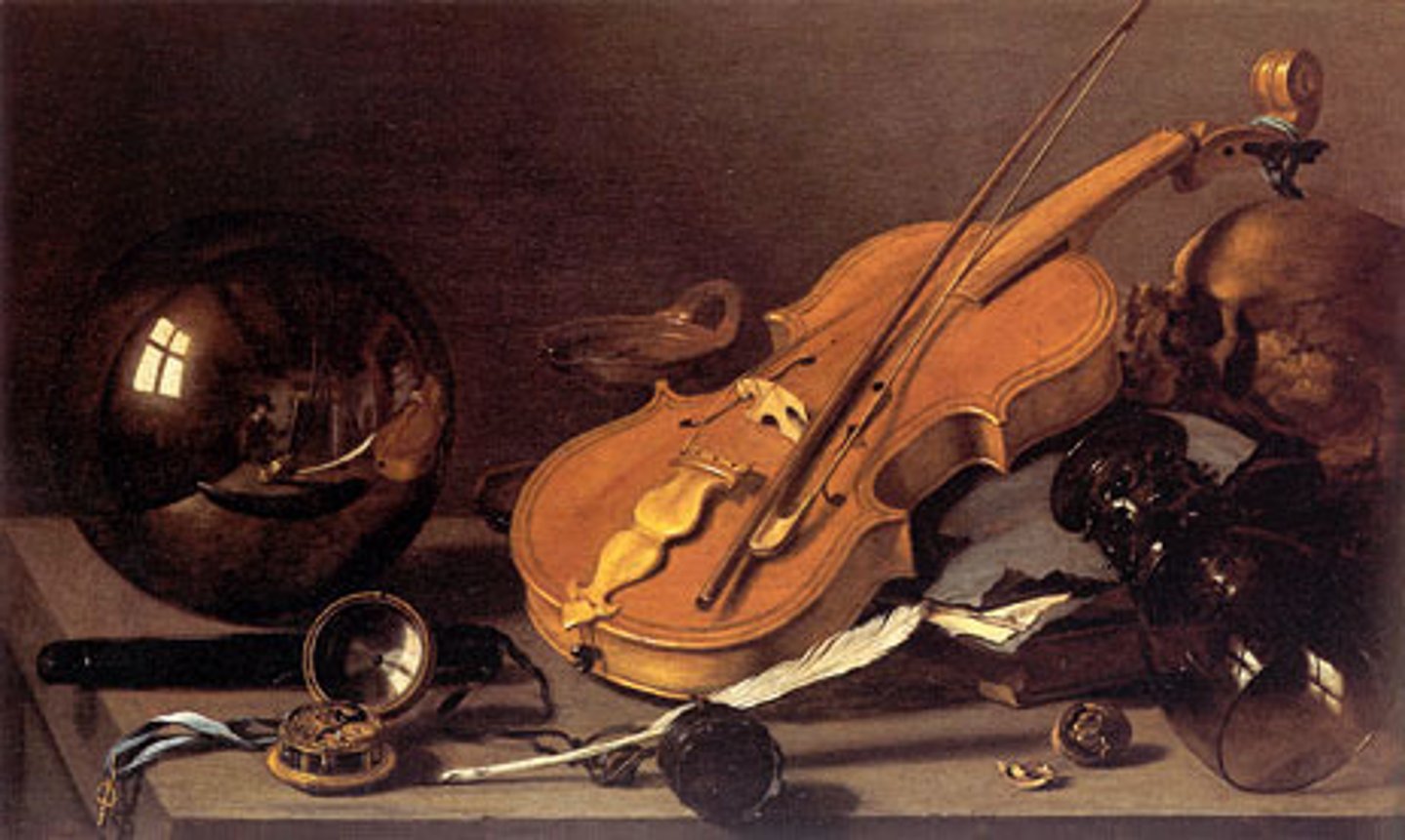
Discuss the iconography of Vermeer's Woman Holding a Balance. How is this painting typical of Vermeer's work? What type of scenes is Vermeer known for?
Vermeer almost always focuses on women and a sense of calm. He gives us a glimpse into what the daily life of the people in the 17th C would have been like. This painting depicts a pregnant woman holding an empty balance next to her box of jewelry in front of a painting of Christ's last judgement. These things represent divine truth or justice.

Using van Ruisdael's View of Haarlem from the Dunes at Overveen, discuss the importance of landscape painting for the 17thc Dutch. Why was landscape the most popular kind of painting in the Dutch Republic?
They liked landscapes because it gave the merchants/middle class pictures of their daily lives.
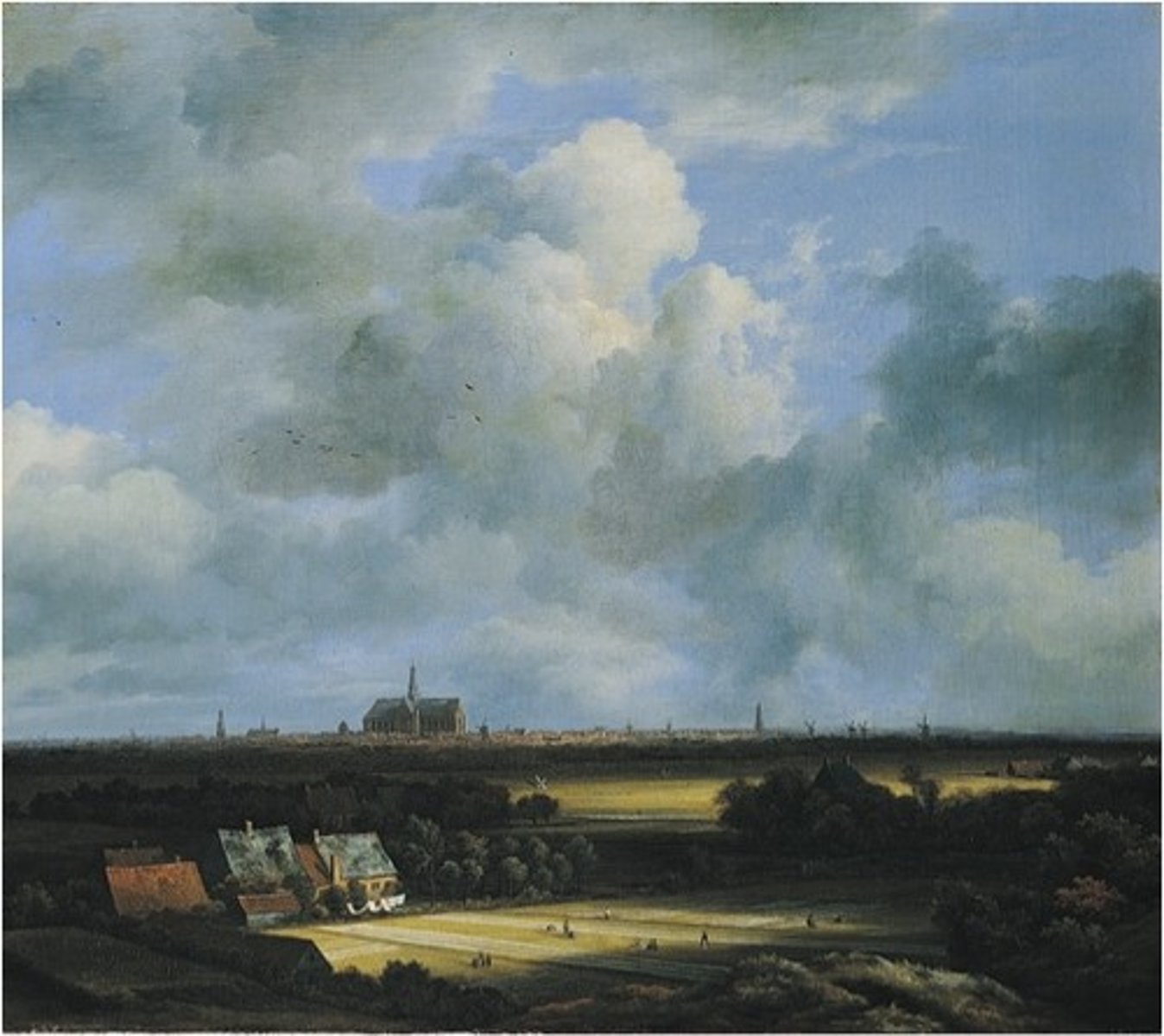
Define Baroque classicism. [hint use Nicolas Poussin's Death of Germanicus in your answer - what are key stylistic elements of Poussin's painting?]
Draws heavily on classical influences, such as naturalism and idealism, but there is more dramatic lighting and such. Poussin uses this in his diagonals, classical armor, contraposto poses, classical perspective and portrayal of anatomy, slightly lessened dramatic lighting, and depicts a scene of a classical story that would have only been known to an elite audience.

What effect did the formation of the French Royal Academy have on art in 17thc France? What stylistic debate eventually divides the Academy at the end of the century?
The French Royal academy determined who was allowed to paint, who the patrons were, and what the purpose of art was. The artists who came out of the academy had the primary task of making Louis XIV look good. Debate formed between followers of Poussin and followers of Reuben. Classical antiquity vs. brushy expression
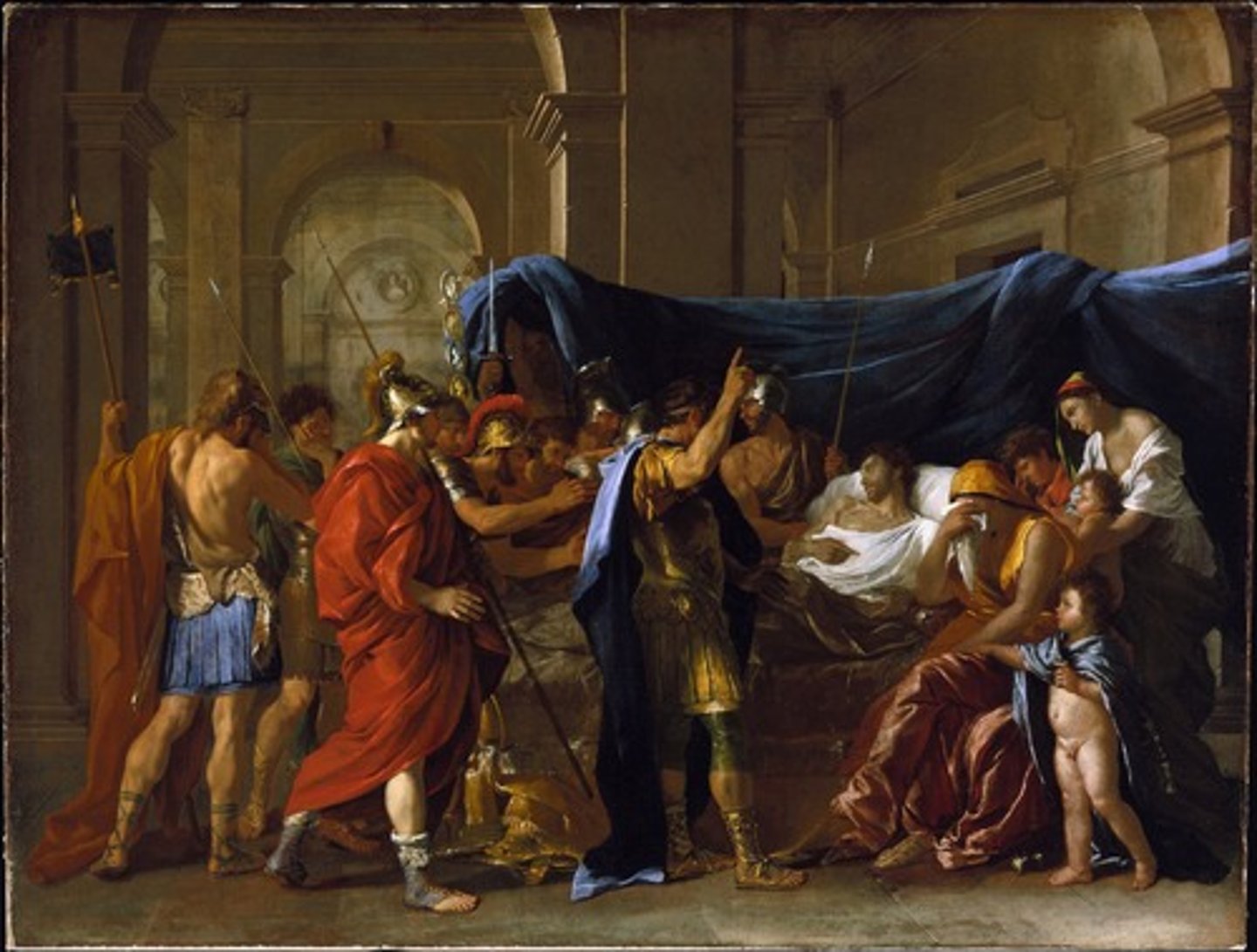
How does Louis XIV harness art to support his reign? What types of works does he commission? What is the "nickname" embraced by Louis XIV and how is this mythic identity expressed in his decoration of his Palace at Versailles?
Louis XIV commissioned paintings that would show his royalty, wealth, and his status above everyone. His nickname was the "Sun King", as in Apollo. He wanted to be the center of the universe, central to the French kingdom, and this can be seen in his Palace at Versailles that had him at the center and was created for us to be in awe of him.
